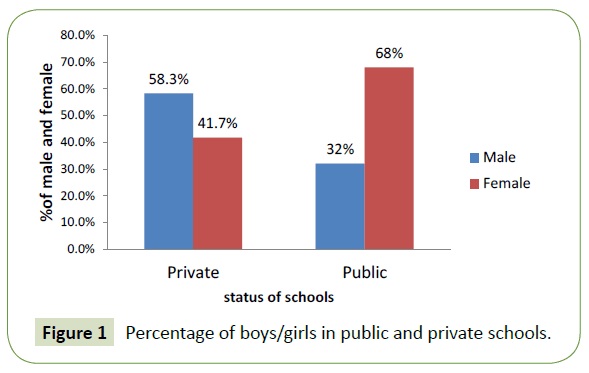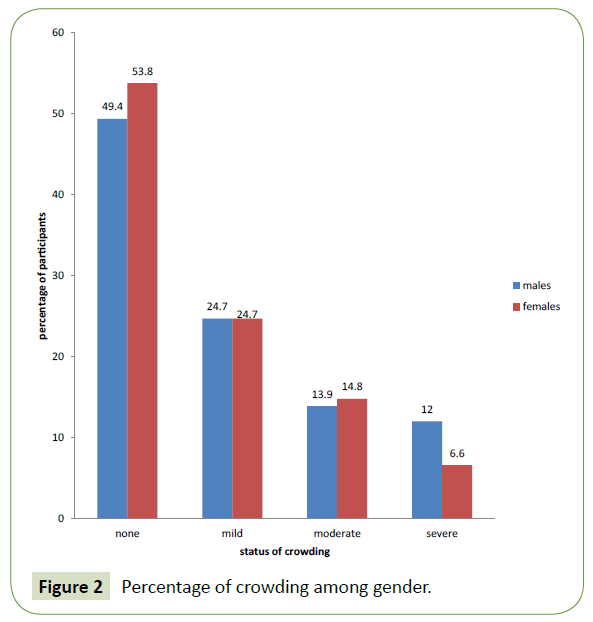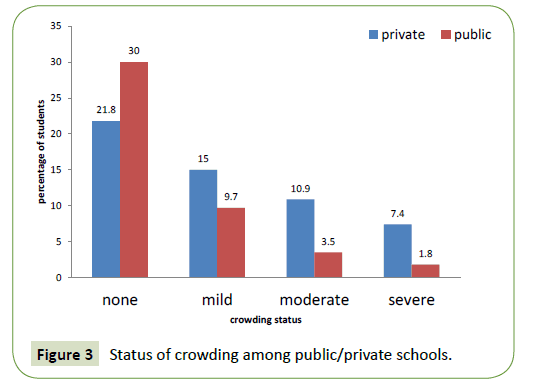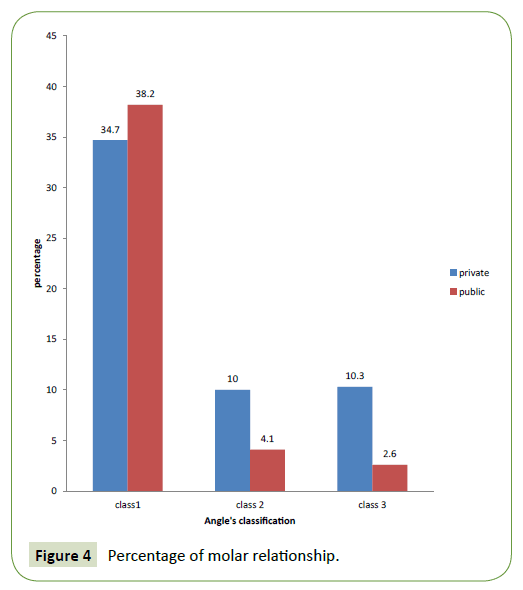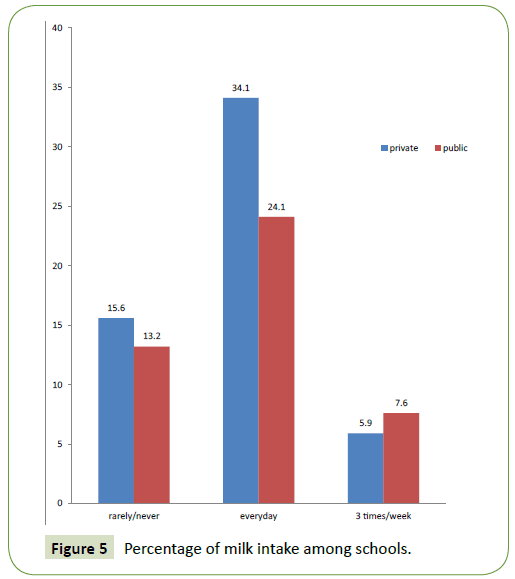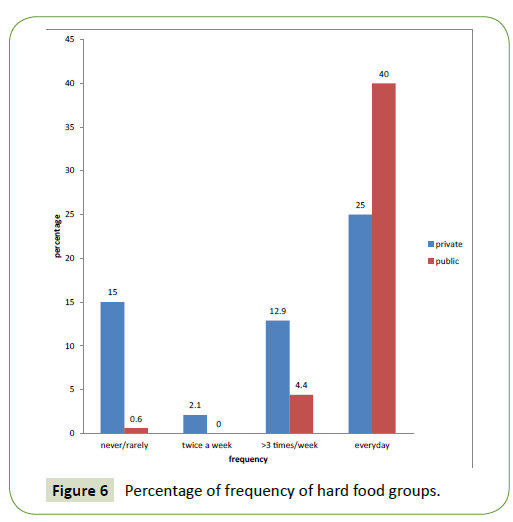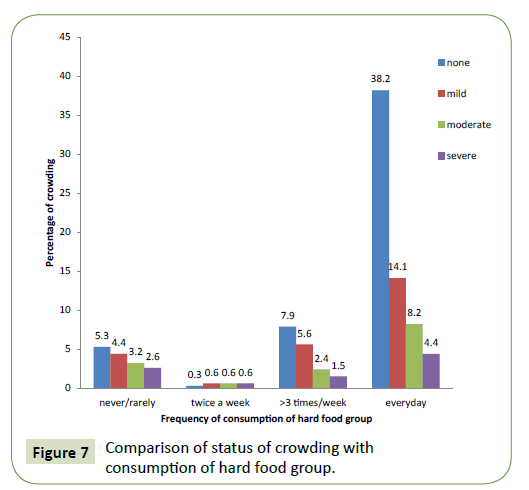Status of Malocclusion in 9-12-year-old Children: A Survey among Private and Public Schools of Islamabad
Sadia Ausim1* and Saima Hamid2
1Center for Global Public Health Pakistan, Islamabad, Pakistan
2Public Health Department, Health Services Academy, Islamabad, Pakistan
- *Corresponding Author:
- Sadia Ausim
Center for Global Public Health Pakistan
Islamabad, Pakistan
Email: sadia_younus@hotmail.com
Received Date: January 03, 2017 Accepted Date: January 10, 2017 Published Date: January 17, 2017
Citation: Ausim S, Hamid S. Status of Malocclusion in 9-12-year-old Children: A Survey among Private and Public Schools of Islamabad. J Med Res Health Educ. 2017, 1:1.
Abstract
Background: Oral health is an integral part of a person’s well-being and health. Malocclusion is not a disease but rather a set of dental deviations which can influence quality of life. The objective of the study is to assess the proportion of malocclusion on school going children between 9-12 years of age in public and private schools of Islamabad.
Methodology: Cross sectional study of 340 schools’ children both from private/ public sectors were conducted. Height and weight along with visual crowding/ molar relationship were taken. Dietary intake questionnaire filled by each student were based on last one week’s food consumption.
Results: A sample of 340 children 9-12 years from private/public schools using convenience sampling technique was collected. Status of crowding revealed 51.8% children with no crowding, 24.7% exhibited mild crowding, 14.4% with moderate and 9.1% with severe malocclusion. Class 1 molar relationship was observed in 72.9% children; class 2 among 14.2% and class 3 in 12.9% children.
Conclusion: The proportion of malocclusion was higher in private school children compared to public school of same age group. The association between consumption of hard and healthy diet with correct status of eruption of teeth was statistically significant. Treating crowding early uplifts self-esteem and recognizing the need for it signifies its related disadvantages and early treated advantages.
Keywords
Dental public health; Healthy diet; Oral health
Introduction
Oral health is an integral part of a person’s well-being and health [1]. It is a state of being free from mouth and facial pain, oral and throat cancer, oral infection, and sores, periodontal (gum) disease, tooth decay, tooth loss, and other diseases and disorders that limit an individual’s capacity in biting, chewing, smiling, speaking, and psychosocial wellbeing. Oral diseases restrict activities in school, at work and at home causing millions of school and work hours used to be lost each year the world over. Moreover, the psychosocial impact of these diseases often significantly diminishes quality of life [1].
Even though there is no comprehensive data on economic costs of oral diseases globally, the WHO estimates that they are the fourth most expensive condition to treat if a curative approach is taken, rather than a focus on prevention [2]. Malocclusion is not a disease but rather a set of dental deviations which in some cases can influence quality of life. There is insufficient evidence that orthodontic treatment improves dental health and function. Treatment is often justified by the enhancement of social and psychological well-being through improvements in appearance [3].
Malocclusion is a condition in the way the upper and lower teeth fit together in biting or chewing. The word malocclusion literally means "bad bite" [4]. The condition may also be referred to as an irregular bite, cross bite, or overbite. Studies on the relationship between children's malocclusion and its psycho-social impacts are quite impressionable. As of 1899 with the malocclusion classification proposed by Angle and the acknowledgement of orthodontics as a dental specialty much has been published on the incidence and prevalence of malocclusion in the population Data from the World Health Organization (WHO) show that malocclusion is the third most important condition in the ranking of oral health problems, outranked only by caries and periodontal disease [5].
Malocclusions have a multifactorial origin and can hardly ever be attributed to a single specific cause. Causes include general factors, such as genetic and hereditary components, nutritional deficiencies and abnormal pressure habits, or local factors, located directly in the dental arch such as supernumerary teeth, tooth decay and premature loss of primary teeth [5].
Nutritional values also play an important role in facial bone development and thus arises the problem of malocclusion. Evidence suggests that energy-protein malnutrition is associated with impaired growth and development of facial bones. The objective of this study is to investigate the association between nutritional status and reduced space for dental eruption (crowding) in permanent dentition. No association was observed between underweight and crowding. Malnutrition is related to crowding in permanent dentition among mouth-breathing adolescents. Policy actions aimed at reducing low height-for-age and unhealthy oral habits are strongly recommended. However, further studies are needed to increase the consistency of these findings and improve understanding of the subject [6].
WHO has put a lot of emphasis on availing treatments for oral problems and has taken up oral health among the most important non-communicable diseases [1]. A research done on Brazilian school children age 10-14 years showed the economic costs that treatment of malocclusions has on people’s lives [7].
Methods
A cross sectional study design was undertaken in two private and two public schools of Islamabad. These schools were selected based on their proximity to each other. Similar age group sample was drawn from all the schools i.e., 9-12 years’ old boys and girls. This was done as the mean age to treat malocclusion is 9-12 years. At this age, all or most of the deciduous dentition are gone and permanent teeth have erupted.
Data were collected using a structured questionnaire consisting of socio-demographic and a dietary intake questions. The questionnaire was adapted from a study done in Brazil for children of same age group. The study questionnaire was pre-tested among 10 children in a dental hospital among children between the ages 9-12 years who attended the clinic for treatment with their parents.
The students with less than six permanent teeth were excluded from the sample population along with those who had some dental disease like microdontia, macrodontia, or were under orthodontic treatment.
Questions regarding demographic variables like name, age, gender, height, weight, were asked from the participants. Physical exam consisted of height weight and facial appearances. Oral exam comprising of visible status of dentition, number of primary teeth, number of permanent teeth, and status of malocclusion were done by the dentist. Dietary intake questionnaire tested the variables like hard/soft food, milk intake; frequency/consistency of meals with relation to public/private sector was kept under consideration.
Results
Data were analyzed using SPSS 20 version and nutritional status was calculated using the WHO ANTHRO plus software. Total of 340 children both from private and public schools were included in the study; private school children were 188 of which 109 (41.7%) were females and 78 (58.3%) were males. Public school comprised of total 154 children consisting of 109 (68%) females and 49 (32%) males (Figure 1).
Table 1 displays the dental and diet related characteristics. Status of crowding (Table 1) in children showed that 176 (51.8%) had no crowding or normal occlusion in both males and females, 84 (24.7%) exhibited mild status of crowding, 49 (14.4%) with moderate and 31 (9.1%) with severe status of malocclusion. Class 1 molar relationship which is taken to be as normal was observed in 248 (72.9%) children, class 2 among 48 (14.2%) and class 3 in 44 (12.9%). BMI within normal range was exhibited by 254 (74.7%) children, 47 (13.8%) and 39 (11.5%) were over and under normal limits respectively (Figure 2).
| Variable | Frequency | Percentage | |
|---|---|---|---|
| Crowding | None | 176 | 51.8 |
| Mild | 84 | 24.7 | |
| Moderate | 49 | 14.4 | |
| Severe | 31 | 9.1 | |
| Molar relationship | Class 1 | 248 | 72.9 |
| Class 2 | 48 | 14.1 | |
| Class 3 | 44 | 12.9 | |
| BMI | Normal | 254 | 74.7 |
| Over | 47 | 13.8 | |
| Under | 39 | 11.5 | |
| Consistency of hard food group | Rarely/never | 48 | 14.1 |
| Yes | 282 | 82.9 | |
| 2 times a week | 10 | 2.9 | |
| Frequency of hard food | Never/rarely | 53 | 15.6 |
| Twice a week | 7 | 2.1 | |
| >3 times a week | 59 | 17.4 | |
| Everyday | 221 | 65 | |
| Milk intake | Rarely/never | 96 | 28.2 |
| 3 times a week | 198 | 58.2 | |
| Everyday | 46 | 13.5 |
Table 1: Dental and diet related characteristics of sample population.
Hard food group was never or rarely consumed by 48 (14.1%) children (Table 1) whereas 282 (82.9%) consumed it regularly.
Only 10 (2.9%) ate hard foods twice a week. 221 (65.5%) of the children ate hard food on daily basis whereas 53 (15.6%) never ate hard food (Table 1).
Status of malocclusion among private and public school children Figure 3 showed that malocclusion was more in children going to private schools as compared to children in public schools (severe crowding status being 7.4% in private school children and 1.8% in public school children).
The difference in crowding status, molar relationship and nutritional status in children going to private and public schools was found to be statistically significant (Tables 2 and 3).
| Variables | Private school n (%) | Public school N (%) |
p-value | |
|---|---|---|---|---|
| Crowding status | Mild | 51(15.0) | 33(9.7) | 0 |
| Moderate | 37(10.9) | 12(3.5) | ||
| Severe | 25(7.4) | 6(1.8) | ||
| None | 74(21.8) | 102(30.0) | ||
| Molar relationship | Class 1 | 118(34.7) | 130(38.2) | 0 |
| Class 2 | 34(10.0) | 14(4.1) | ||
| Class 3 | 35(10.3) | 9(2.6) | ||
| Nutritional status | Normal | 133(39.1) | 121(35.6) | 0.001 |
| Over | 37(10.9) | 10(2.9) | ||
| Under | 17(5.0) | 22(6.5) |
Table 2: Comparison of dental and nutritional status in public and private school going children.
| N (%) | p-value | ||||
|---|---|---|---|---|---|
| Never/rarely | Twice a week | >3 times/week | Everyday | ||
| None | 18(5.3) | 1(0.3) | 27(7.9) | 130(38.2) | 0.013 |
| Mild | 15(4.4) | 2(0.6) | 19(5.6) | 48(14.1) | |
| Moderate | 11(3.2) | 2(0.6) | 8(2.4) | 28(8.2) | |
| Severe | 9(2.6) | 2(0.6) | 5(1.5) | 15(4.4) | |
Table 3: Cross tabulation of status of crowding and frequency of hard food group.
Molar relationship was assessed on Angle’s classification (Figure 4). Results showed difference in Class 3 molar relationship of 34 (10.3%) in private school as compared to 10 (2.6%) in public; Class 2 displayed difference of 35 (10%) in private with only 10 (4.1%) in public school.
Class 1 relationship taken to be as normal was almost same in both types of school children i.e., 118 (34.7%) in private and 130 (38.2%) in public schools (Figure 4).
Milk intake was higher among students in private school as compared to those going to public school. Majority (34.1% in private school) took milk daily and 5.9% at least thrice a week (Figure 5).
Figure 6 compares the frequency of consumption of hard food group among schools of private and public school children. The intake of hard food on everyday basis was higher in public school with 40% as compared to 25% in private. The results of status of visual crowding with frequency of hard food group consumption were also statistically significant.
The results for status of crowding with frequency of hard food group consumption on everyday basis were significant with almost 40% of students with no crowding (Figure 7).
The students who rarely consumed hard food group exhibited 4.4% mild, 3.2% moderate and 2.6% severe crowding.
Discussion
Oral health is an important part of one’s health. WHO identifies it as a basic requirement for all human beings especially for children and elderly [1]. People today and in the past, have equated success in all aspects of life with good appearances especially dental appearance [8]. Socio economic impact of dental treatments is also at large especially for malocclusion. The field which deals with treatment of crowding is orthodontics and has recently been recognized as the most expensive field of dentistry. Aesthetics can uplift a person’s spirit to a higher level in the
community providing him with satisfaction in employment and socialization [9-11]. The age group 9-11 years is the right time to start treating the condition as children grow fast and go through a lot body changes including pubertal changes. This is particularly so for girls. The children with better oral aesthetics have shown to perform better in schools i.e., getting better grades and socially more interactive [12].
Many researches done in world have emphasized the importance of treating malocclusion at the right stage and age. Treating conditions like crowding early uplifts self-esteem in children [12]. Recognizing the need for it by the parents and care givers signifies its related disadvantages and early treated advantages [13,14].
The crowding status was comparatively better among public school students than private school ones despite their belonging to better economic status homes. The hard food group was adapted from Oral Health and Nutrition Guidance for Professionals [15], which was made context-specific based on the local, cultural, and economic factors, and food choices. Children belonging to a comparatively less privileged community were consuming wheat flour and crunchy vegetables on daily basis whereas children belonging to the higher socio economic circle were eating more soft foods and were less fond of chapattis or crunchy diet. They were consuming significant amount of soft food groups like naan and pita breads and were fond of snacks. While the children from public school consumed very less amounts of soft food group which might to be due to issues like accessibility and affordability.
Research suggests that the status of malocclusions actually exists due to less space availability for the teeth to erupt in both upper and lower jaws [14]. The problem is also associated with less developed craniofacial structures that can be due to the less utilization of forces of mastication or too much inclusion of soft foods in our diet today [16].
This tremendous reduction in the forces of mastication, the subsequently reduced jaw involvement; thus, as modern food preparation techniques spread throughout the world during the 19th century, so did dental crowding.
As far as the nutritional status was concerned the results showed no association between children being under weight or over weigh and status of malocclusion and there was no clear evidence that status of malocclusion has any definitive relationship with weight, yet the consumption of soft foods is still associated with compromised chewing forces thus affecting the occlusion status [17]. Since the study undertaken was a cross-sectional one, the associations seen can only be explored to generate hypotheses for future studies.
Milk intake was also assessed for consumption and frequency. The results showed that regular consumers of milk had better status of teeth than those who were not taking milk in their diets on regular basis. This difference was found to be statistically significant. This finding is consistent with the evidence that calcium intake is associated with better eruption of teeth and craniofacial bone structure including mandible [17].
The educational and professional statuses variables were removed from the questionnaire as they were unacceptable by both the private and public school administration. Thus, it was not possible to explore association between parental educational status or economic conditions with status of malocclusion [18].
Children belonging to private school were quite familiar with all the dental terminologies that were being used by the dentist and had fair knowledge regarding the visits to dental offices on regular basis. They were quiet keen to learn more.
In comparison, public school children were less familiar with terminologies and indicated that they had less visits to dental offices or hospitals. They had good dental practices and kept good oral hygiene. Proper brushing and rinsing habits were observed by all children and they had fair knowledge regarding the good diet for healthy teeth. The PI came across a case of microdontia in public school in a female student. She was excluded from the study. She however was advised to seek care at a dental hospital for better understanding of the disease and further treatment [19].
Higher proportion of children going to private schools had malocclusion as compared to children going to government school. An association between consumption of hard and healthy diet with correct status of eruption of teeth was seen which needs further exploration in a prospective study. Frequency of hard food group (such as wheat and milled products like chappatis and parathas) on everyday basis was found better among the group with less malocclusion as compared to the group who were not consuming it regularly. Children going to private schools had more knowledge about oral health regarding oral hygiene practices and regular visits to dental office. Public school children though knowledgeable about brushing and rinsing, did not routinely go for dental consultation [20].
Acknowledgment
This research was partially supported by Health Services Academy Islamabad Pakistan. The author thanks her supervisor from the institute who provided insight and expertise that greatly assisted the research, although they may not agree with all the interpretations/conclusions of this paper.
Ethical Consideration
Ethical approval for this research was obtained from the ethical committee of Health Services Academy Islamabad Pakistan.
Declaration
There are no competing interests from anyone.
References
- Petersen PE (2003) The World Oral Health Report 2003: Continuous improvement of oral health in the 21st century-the approach of the WHO Global Oral Health Programme. Community Dentistry and Oral Epidemiology 31: 3-24.
- Oral health worldwide (2014) a report by FDI worldwide dental federation.
- Shaw W (2002) Dentofacial irregularities. In: Pine C (ed.) Community Oral Health Elsevier Science Limited, pp: 104-111.
- Malocclusion (2008) Mosby's Dental Dictionary, 2nd edition.
- Bittencourt MAV, Machado AW (2010) An overview of the prevalence of malocclusion in 6 to 10-year-old children in Brazil. Dental Press J Orthod 15: 113-122.
- Thomaz EBAF, Cangussu MCT (2010) Is Malnutrition Associated with Crowding in Permanent Dentition. Int J Environ Res Public Health 7: 3541-3544.
- Zhang M, McGrath C, Hagg U (2006) The impact of malocclusion and its treatment on quality of life: a literature review. Int J Paediatr Dent 16: 381-387.
- Lemshaw Stanley. Adequacy of sample size in health studies. 1st ed. Chis Chester, New York, Brisbane, Toronto, Singapore. John Wiley & Sons.
- https://www.who.int/topics/nutrition/en/
- Oral Health and Nutrition Guidance for Professionals (2012) Published by NHS Health Scotland Woodburn House Canaan Lane, Edinburgh EH10 4SG.
- Shivakumar KM, Chandu GN, Subba RVV, Shafiulla MD (2009) Prevalence of malocclusion and orthodontic treatment needs among middle and high school children of Davangere city, India by using Dental Aesthetic Index. J Indian Soc Pedod Prev Dent 27: 211-218.
- Sureshbabu AM, Chandu GN, Shafiulla MD (2005) Prevalence of malocclusion and orthodontic treatment needs among 13-15-year-old school going children of Davangere city, Karnataka, India. J Indian Assoc Public Health Dent 6: 32-35.
- Ansai T, Miyazaki H, Katoh Y, Yamashita Y, Takehara T, et al. (1993) Prevalence of malocclusion in high school students in Japan according to the Dental Aesthetic Index. Community Dent Oral Epidemiol 21: 303-305.
- Franchi L, Pavoni C, Faltin K Jr, McNamara JA Jr (2013) Long-term skeletal and dental effects and treatment timing for functional appliances in Class II malocclusion. Epub 83: 334-340.
- Luciana MDDS, Yoshiaki ODDS, Yuzo TDDS (2001) Indicators of mandibular dental crowding in the mixed dentition. Am Acad Pediatr Dent 23: 2.
- https://www.who.int/oral_health/strategies/en/
- Das UM, Beena JP, Azher U (2009) Oral health status of 6 and 12-year-old school going children in Bangalore city: An epidemiological study. J Indian Soc Pedod Prev Dent 27: 6-8.
- Jose AA, Joseph MRB (2003) Prevalence of dental health problems among school going children in rural Kerala. J Indian Soc Pedod Prev Dent 21: 147-51.
- Flores XDS, Benavides RCR, Barrera JC, Rodríguez JDL (2013) Prevalence of caries, gingivitis and malocclusions in school-age children in Ciudad Victoria, Tamaulipas, and its relationship with their nutritional status. Revista Odontológica Mexicana 17: 217-223.
- Paula J, Leite I, Almeida A, Ambrosano G, Pereira A, et al. (2012) The influence of oral health conditions, socioeconomic status and home environment factors on schoolchildren's self-perception of quality of life. Health and Quality of Life Outcomes 10: 6.
Open Access Journals
- Aquaculture & Veterinary Science
- Chemistry & Chemical Sciences
- Clinical Sciences
- Engineering
- General Science
- Genetics & Molecular Biology
- Health Care & Nursing
- Immunology & Microbiology
- Materials Science
- Mathematics & Physics
- Medical Sciences
- Neurology & Psychiatry
- Oncology & Cancer Science
- Pharmaceutical Sciences
